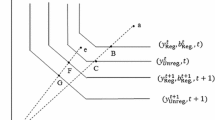Abstract
Ozone in the South Cast Air Basin, which encompasses the urbanized portions of Los Angeles, Orange, Riverside, and San Bernardino counties in California, currently exceeds the federal standard. Rules on stationary sources have been adopted to reduce emissions of two ozone precursors, reactive organic gases (ROG) and nitrogen oxides (NOx). This paper uses an input-output framework to evaluate the distributional impacts of four of the most costly NOx rules on the South Coast economy in terms of output, income, employment, and prices. The model allows output substitutions by making the household sector endogenous and feeding price elasticities into personal consumption coefficients. Instead of using annualized costs, it is assumed that the rate of industrial compliance to NOx rules follows an accelerating pattern during the simulation period of 1984 to 1988; i.e., from the time a rule was adopted to the time it will be complied with. It is found that the highest price increase occurs in Petroleum Refineries in 1988 (.48 percent). The overall results indicate that price impacts are rather insignificant.
Similar content being viewed by others
References
Bureau of Labor Statistics, Department of Commerce. “Output Projections by Industry.” November 1983.
California Manufacturers Register, 1984. Los Angeles, CA: Time Mirror Press.
Evans, M. K. “A Forecasting Model Applied to Pollution Control Costs.”American Economic Review, 63 (1973): 224–256.
Giarrantani, F. “Air Pollution Abatement: Output and Relative Price Effects, A REgional Input-Output Simulation.”Environment and Planning A, 6 (1974): 307–12.
Haring, J. E. and Van Deventer, A. “Indirect and Induced Benefit-Cost Analysis: A Case Study.”Review of Economics and Statistics, 60 (1978): 312–17.
Hollenbeck, K. “The Employment and Earnings Impacts of the Regulation of Stationary Source Air Pollution.”Journal of Environmental Economics and Management, 6 (1979): 208–221.
The INFORUM Subscribers Meeting Book, June 1984, Interindustry Forecasting Project, College Park, Maryland.
“The Input-Output Structure of the U.S. Economy, 1977.”Survey of Current Business. Interindustry Economics Division, Bureau of Economic Analysis, U.S. Department of Commerce. May 1984.
Leontief, W. W. “Environmental Repercussions and the Economic Structure: An Input-Output Approach.”Review of Economics and Statistics, 52 (1970): 262–71.
Liew, C. K. and Liew, C. J. “Measuring the Development Impact of a Transportation System: A Simplified Approach.”Journal of Regional Science, 25 (1985): 241–257.
Lofting, E. “Input-Output Table of the South Coast Air Quality Management District.” Computer Tape. 1984.
Pai, G. “Environmental Pollution Control Policy: An Assessment of Regional Economic Impacts.” Unpublished Ph.D. Dissertation. Massachusetts Institute of Technology. June 1969.
Pasurka, C. A., Jr. “The Short-Run Impact of Environmental Protection Costs to U.S. Product Prices.”Journal of Environmental Economics and Management, 11 (1984): 380–390.
Pleeter, S.Economic Impact Analysis; Methodology and Applications. Boston: Martinus Nijhoff Publishing (1980).
Rose, A. “Modeling the Macroeconomic Impact of Air pollution Abatement.”Journal of Regional Science, 23 (1983): 441–459.
Rose, A. “A Simulation Model for the Economic Assessment of Alternative Air Pollution Regulations.”Journal of Regional Science, 17 (1977): 327–344.
U.S. Department of Commerce, National Income and Product Tables-Personal Consumption Expenditures by Type of Expenditures,Survey of Current Business, July 1979 & 1984.
Author information
Authors and Affiliations
Additional information
This paper was written while the author was with the South Coast Air Quality Management District. The opinions expressed in this article are those of the author and do not necessarily reflect the views of the South Coast Air Quality Management District.
Rights and permissions
About this article
Cite this article
Lieu, T.S. Impacts of air pollution control costs: An input-output approach. Ann Reg Sci 20, 55–65 (1986). https://doi.org/10.1007/BF01287241
Received:
Revised:
Issue Date:
DOI: https://doi.org/10.1007/BF01287241




